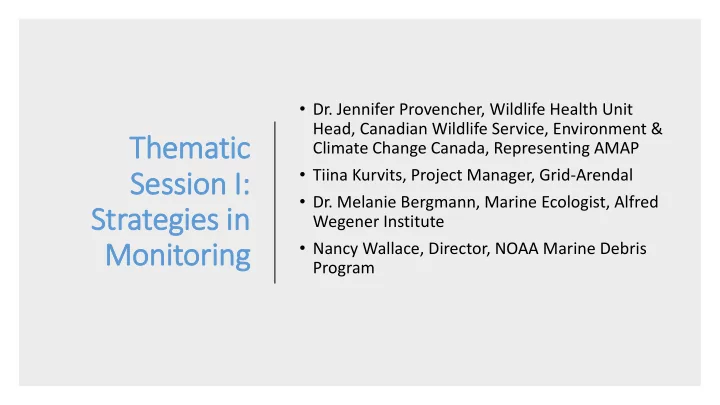

• Dr. Jennifer Provencher, Wildlife Health Unit Head, Canadian Wildlife Service, Environment & Thematic Climate Change Canada, Representing AMAP • Tiina Kurvits, Project Manager, Grid-Arendal Session I: I: • Dr. Melanie Bergmann, Marine Ecologist, Alfred Strategies in Wegener Institute • Nancy Wallace, Director, NOAA Marine Debris Monitoring Program
Work rkshop on Arctic Pla lastic Poll llution 30 30-31 October 2019 Thematic Session 1: Strategies in Monitoring
AMAP monitoring in init itiatives Dr. Jennifer Provencher, Wildlife Health Unit Head, Canadian Wildlife Service, Environment & Climate Change Canada
Variation in in pla lastics in ingestion in in seabirds across la large spatial scales Arctic Temperate Arctic Temperate Arctic Temperate Frequency of occurrence over birds with > 0.1 g of plastics OSPAR Ecological Quality Objective (EcoQO) target
Cooperation and coordination among th the Arctic Council WGs Litter and Microplastic Arctic Migratory Birds Microplastic Expert Expert Group (LMEG) Initiative (AMBI) Group Seabird and Plastics Monitoring Regional Action Plans work supported by PSI Assessment Air Fulmars Sediments/Soil Eiders Actions Fish Murres Seabirds Gulls Measurable Polymer ID Kittiwakes targets Accountability metrics Skuas Data management
Key fi findings fr from PAME desktop study Tiina Kurvits, Project Manager, Grid-Arendal
Sect ction III. III.2 Path thways and Dis Distribution The pathways for marine litter into and round the Arctic - Oceanic Transport (Currents and sea-ice drift) - Riverine Transport (Potentially important) - Atmospheric Transport - Biological Transport Population in the Ob’, Yenisey and Lena watersheds, which extend beyond Arctic boundaries, is 38 million people, an order of magnitude larger than the population of the entire Arctic region.
Some key messages • Land based sources are currently not as important as sea-based sources , which is different to most regions of world (where marine litter is strongly correlated with human population densities on land) • Fisheries is a major source of marine litter • Aquaculture, passenger and goods, shipping, and oil and gas exploration activities constitute additional sea-based sources. • For land-based sources, deficient waste and wastewater management systems in some coastal Arctic communities are an important localized source of marine litter. • Arctic acts as a sink, receiving marine plastic from elsewhere , but the proportion of marine litter, including microplastics, arriving from distant sources is difficult to gauge against the local sources • Marine litter can be found in all reservoirs (sea ice, sediments, water column, food chain) • Contribution of rivers still a question mark and deserves further research
Pathways of f marine pla lastic Dr. Melanie Bergmann, Marine Ecologist, Alfred Wegener Institute
Time Series of Debris on Deep Ocean Floor HAUSGARTEN / FRAM Time Series 2500 m water depth (Source: Geology.com, T.Soltwedel) (Bergmann & Klages 2012; Tekman et al. 2017, Deep-Sea Res; Dirksen unpubl. ) Marine debris increases on the deep Arctic seafloor
FRAM Pollution Observatory Plastic debris Microplastic Arctic snow Ø = 1,800 N L -1 Sea ice Sea surface Ø = 4,500 N L -1 Ø = 27 items km -2 Sea surface Ø = 0.51 N L -1 Sample plastic debris Water column Ø = 0.19 N L -1 in different ecosystem compartments to identify sinks and pathways Deep-sea sediment Deep seafloor Ø = 2,300 N L -1 Ø = 8.081 items km -2 Repeat measurements to deduce temporal Plastic accumulates in deep-sea sediments and sea ice trends (Based on: Bergmann&Klages 2012, Bergmann et al. 2016;2017; 2019; Peekenet al.2018; Tekman et al. 2016;in rev.)
Arctic Mari rine Debris Nancy Wallace, Director, NOAA Marine Debris Program
Arctic Marine Debris – Actions, Challenges, Opportunities NPS Arctic MD Removal Sites USFWS MDMAP Data Analysis Pribilof Islands MD UAS Survey Imagery Alaska MD Aerial Survey – 2014-2015
Dis iscussions/Questions
Discussion points • What are the most important things we should be monitoring if we can’t track everything? • How do we coordinate the differences between harmonization and standardization? • What information do we want from monitoring? • What are the target regions for actions and monitoring? • What strategies are being used globally that may be useful in an Arctic context? • How can scientific collaboration among Arctic states simplify the monitoring process? • What strategies can Arctic nations use to meet monitoring needs
Recommend
More recommend